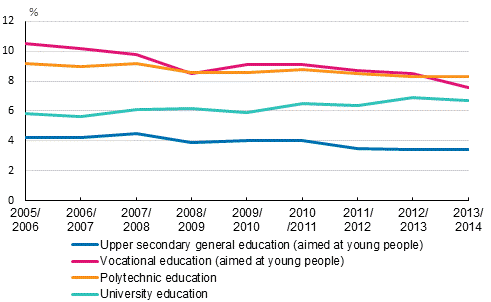Published: 17 March 2016
Discontinuation of education decreased
In all, 5.4 per cent of students attending education leading to a qualification or degree discontinued their studies and did not resume them in any education leading to a qualification or degree during the 2013/2014 academic year. Compared to the year before, discontinuation decreased in vocational education and university education and remained unchanged in upper secondary general education and polytechnic education. These data derive from Statistics Finland’s Education Statistics.
Discontinuation of education in upper secondary general, vocational, polytechnic and university education in academic years from 2005/2006 to 2013/2014, %

The percentages of discontinuation were 3.4 per cent in upper secondary general education aimed at young people, 7.6 per cent in vocational education aimed at young people, 8.3 per cent in polytechnic education (polytechnic degrees), and 6.7 per cent in university education (lower and upper university degrees) in the academic year 2013/2014.
If students who have changed their sectors of education, e.g. students who have switched from upper secondary general school to vocational education, are not calculated as discontinued students, the percentages of discontinuation are lower. Students in polytechnic education and in upper secondary general education changed their sector of education most frequently. Women changed their sector of education slightly more eagerly than men.
Men discontinued their education leading to a qualification or degree completely more often than women in all sectors of education. Men discontinued most often their polytechnic education and women their vocational education. Men discontinued their studies in their own sectors of education more often than women except for vocational education.
Education was discontinued most often in the field of natural sciences, in the field of natural resources and the environment, and in the field of tourism, catering and domestic services. The relative share of discontinuation was lowest in the fields of other education, which includes e.g. military, border guard, and fire and rescue training, and in the field of social services, health and sports.
Discontinuation of education leading to a qualification or degree by sex and sector of education in academic year 2013/2014 1)
| Sex / sector of education | Number of students used in the statistics on discontinuation of education 20 Sept. 2013 | Discontinued in own sector of education | Changed sector of education | Discontinued completely education leading to a qualification or degree | |
| % | % | % | |||
| Total | 491 057 | 6,7 | 1,3 | 5,4 | |
| Men and women | Upper secondary general education (aimed at young people) | 96 270 | 3,4 | 1,8 | 1,6 |
| Vocational education (aimed at young people) | 125 541 | 7,6 | 0,8 | 6,9 | |
| Polytechnic education (Bachelor’s degrees) | 128 539 | 8,3 | 1,9 | 6,4 | |
| University education (Bachelor’s and Master’s degrees) | 140 707 | 6,7 | 0,9 | 5,8 | |
| Men | Total | 234 229 | 7,5 | 1,2 | 6,3 |
| Upper secondary general education (aimed at young people) | 41 388 | 3,6 | 1,7 | 1,9 | |
| Vocational education (aimed at young people) | 67 096 | 7,5 | 0,5 | 7,0 | |
| Polytechnic education (Bachelor’s degrees) | 60 100 | 10,2 | 1,9 | 8,2 | |
| University education (Bachelor’s and Master’s degrees) | 65 645 | 7,5 | 1,0 | 6,5 | |
| Women | Total | 256 828 | 6,0 | 1,4 | 4,6 |
| Upper secondary general education (aimed at young people) | 54 882 | 3,2 | 1,8 | 1,4 | |
| Vocational education (aimed at young people) | 58 445 | 7,8 | 1,1 | 6,7 | |
| Polytechnic education (Bachelor’s degrees) | 68 439 | 6,7 | 1,9 | 4,8 | |
| University education (Bachelor’s and Master’s degrees) | 75 062 | 6,0 | 0,9 | 5,1 | |
Of students aged 18 or over who discontinued upper secondary general school education, 42 per cent continued studies leading to a qualification or degree in some other sector of education, and 16 per cent started working. The corresponding figures were 9 and 23 per cent in vocational education, 23 and 52 per cent in polytechnic education, and 14 and 58 per cent in university education. The employment data are based on Statistics Finland's employment statistics.
More information related to the progress of studies is available from statistics describing Progress of studies and Employment of students.
In 2014, 844 students discontinued apprenticeship training during the four-month probationary period, which is 1.7 per cent of all students in apprenticeship training. In all, 3,385 students discontinued apprenticeship training after the probationary period, which is 6.8 per cent of all students in apprenticeship training. The total number of students in apprenticeship training was 49,856 in 2014.
A total of 372 students had discontinued studies in one way or another in comprehensive school during the 2014/2015 academic year. The number of those who had completely dropped out from compulsory education in the spring term was 71 and those over the age of compulsory education having left school without a leaving certificate from comprehensive school was 301. More than one-half of school drop-outs were boys. The number of boys among those who had completely dropped out from compulsory education was 42, and 179 among those having left comprehensive school without a leaving certificate.
Source: Education. Statistics Finland
Inquiries: Heli Hiltunen 029 551 3314, koulutustilastot@stat.fi
Director in charge: Jari Tarkoma
Publication in pdf-format (223.2 kB)
- Tables
-
Tables in databases
Pick the data you need into tables, view the data as graphs, or download the data for your use.
Appendix tables
Updated 17.3.2016
Official Statistics of Finland (OSF):
Discontinuation of education [e-publication].
ISSN=1798-9302. 2014. Helsinki: Statistics Finland [referred: 19.4.2024].
Access method: http://www.stat.fi/til/kkesk/2014/kkesk_2014_2016-03-17_tie_001_en.html

